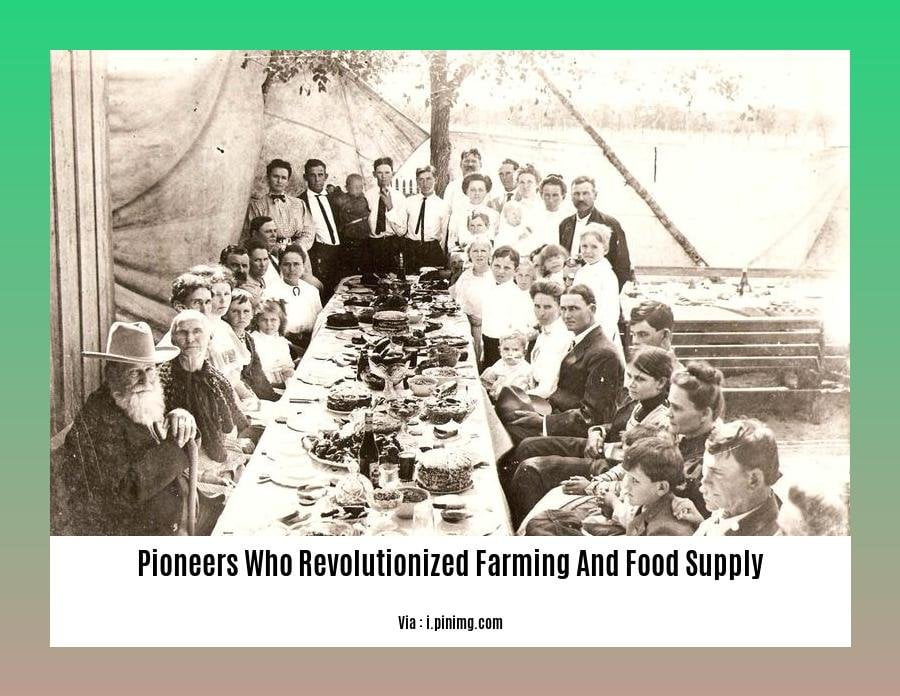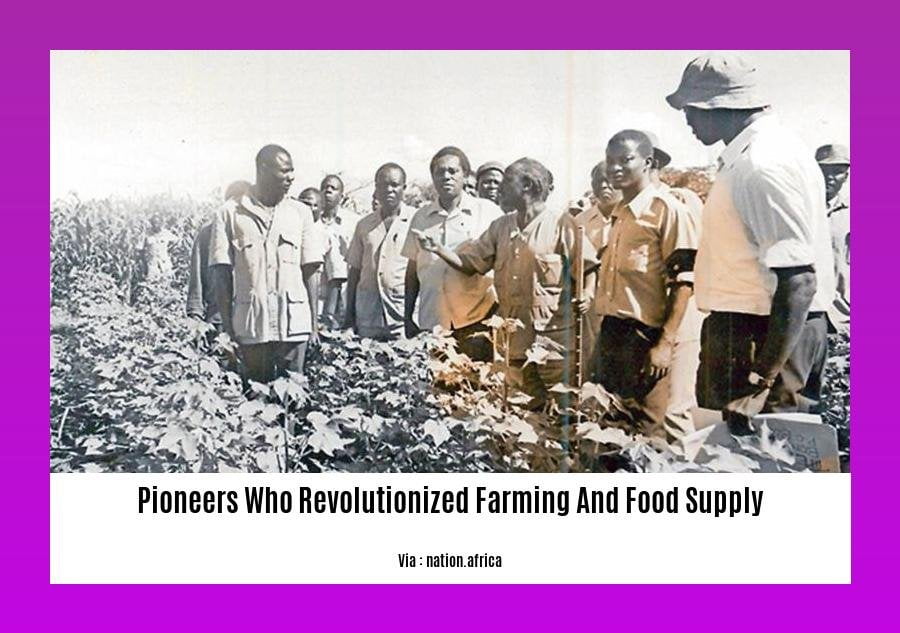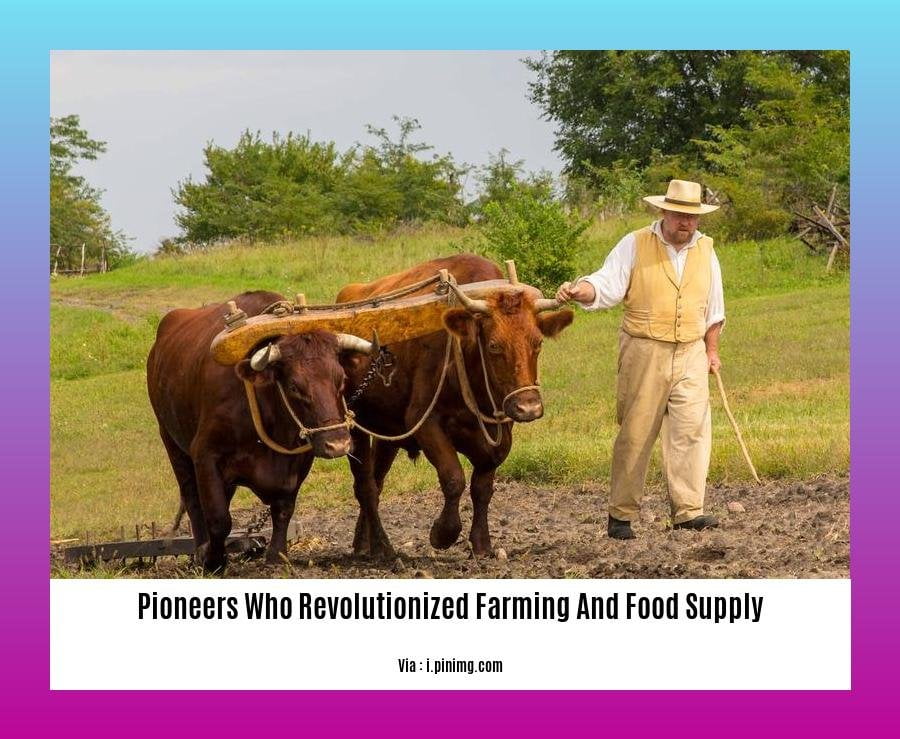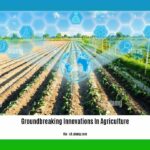Get ready to delve into “Pioneers Who Revolutionized Farming and Food Supply: A Historical Perspective,” an exploration of the trailblazers who transformed agriculture and shaped our food system.
Key Takeaways:

- Women’s significant contributions to advancements in farming and food supply throughout history include:
- María Sibylla Merian’s groundbreaking work on insect biology
- Harriet Williams Rusell Strong’s revolutionary irrigation techniques
- Mary Engle Pennington’s pioneering food safety and preservation methods
- Alice Evans’ advances in the dairy industry
- Rachel Carson’s pivotal role in the environmental movement
Pioneers Who Revolutionized Farming and Food Supply
Throughout history, countless individuals have dedicated their lives to transforming the way we produce and consume food. From the pioneers who revolutionized farming and food supply in the early days of agriculture to the innovators of modern times, these trailblazers have shaped the very foundation of our food system.
Early Innovators:
- The Ancient Egyptians: Developed irrigation systems, cultivated crops, and domesticated animals, laying the groundwork for modern farming practices.
- Jethro Tull (1674-1741): English inventor who introduced the seed drill, revolutionizing crop planting and increasing yields.
- George Washington Carver (1864-1943): American agricultural scientist who developed hundreds of uses for peanuts and soybeans, diversifying crop production.
Modern Advancements:
- Norman Borlaug (1914-2009): American agronomist known as the “father of the Green Revolution,” whose high-yield wheat varieties saved millions from starvation.
- John Deere (1804-1886): American inventor who developed the self-cleaning steel plow, greatly increasing farming efficiency.
- Elizabeth Coleman (1926-2018): American animal scientist who pioneered artificial insemination techniques, improving livestock quality.
Women in Agriculture:
- Women played a pivotal role in agriculture, making significant contributions despite often facing societal barriers.
- María Sibylla Merian: German entomologist whose groundbreaking work on insects provided valuable insights into crop pests.
- Harriet Williams Rusell Strong: American water conservationist who developed irrigation systems that transformed arid regions into productive farmland.
Sustainable Solutions:
- In recent years, a focus on sustainability has driven agricultural innovation.
- Precision farming: Uses GPS and sensors to optimize crop management, reducing environmental impact.
- Vertical farming: Cultivating crops in vertical structures within controlled environments, addressing space constraints and food security concerns.
Continuing Legacy:
The legacy of these pioneers who revolutionized farming and food supply continues to inspire innovation today. By drawing upon the insights and advancements of the past, we can continue to push the boundaries of agricultural technology, ensuring a sustainable and nutritious food supply for generations to come.
Uncover the fascinating stories of the innovators behind major agricultural advancements whose brilliant minds revolutionized the way we cultivate and sustain our food sources. From the groundbreaking innovations in agriculture](../groundbreaking-innovations-in-agriculture) that have transformed farming practices to the agricultural trailblazers and their breakthroughs that have shaped the industry, explore the transformative contributions that have shaped the future of agriculture.
George Washington Carver and his pioneering work on crop rotation and soil conservation
Key Takeaways:
- Carver’s crop rotation methods improved soil health and crop yields.
- He promoted alternative cash crops, such as soybeans and sweet potatoes, enriching the soil and providing farmers with additional income.
- Carver’s chemurgy research explored non-food uses for crop products.
- He educated generations of black students, empowering them with farming knowledge and self-sufficiency.
Carver’s Impact on Agriculture
George Washington Carver’s dedication to agricultural science has left an enduring legacy on farming practices. His innovative crop rotation techniques helped farmers maintain soil fertility and increase crop yields, safeguarding the long-term productivity of their land. Moreover, his advocacy for alternative cash crops, such as soybeans and sweet potatoes, provided farmers with additional sources of income while enriching the soil.
Carver’s pioneering research in chemurgy, the utilization of crop products for non-food purposes, opened up new possibilities for the agricultural industry. He developed innovative uses for crops, including paints, dyes, and medicines, creating additional revenue streams for farmers and expanding the value of agricultural products.
Empowering the Next Generation of Farmers
Carver was not only a brilliant scientist but also a dedicated educator. He taught generations of black students at Tuskegee Institute, imparting his agricultural knowledge and empowering them with the skills to improve their farming practices and achieve self-sufficiency. His passion for education extended beyond the classroom; he established agricultural clubs and organized community demonstrations to share his findings with farmers and the public.
A Legacy of Innovation and Inspiration
Carver’s unwavering determination to improve the lives of farmers and the agricultural industry continues to inspire new generations of agricultural scientists. His pioneering work laid the foundation for sustainable farming practices and the development of new crop products. His legacy serves as a reminder of the power of innovation, perseverance, and the transformative impact that one person can have on the world through the pursuit of knowledge.
Citation: George Washington Carver – Wikipedia
Norman Borlaug and the Development of High-Yield Wheat Varieties
Norman Borlaug, an agronomist who dedicated his life to increasing global food production, made significant contributions to agriculture. During the mid-20th century, he developed semi-dwarf, high-yield, disease-resistant wheat varieties, which played a crucial role in the Green Revolution.
- Borlaug believed that increasing agricultural productivity was essential to alleviating global hunger.
- He spent decades experimenting with different wheat varieties, crossing Japanese dwarf wheat with Mexican wheat to create a semi-dwarf wheat that was both productive and resistant to disease.
- The introduction of these high-yield wheat varieties in Mexico, Pakistan, and India during the 1960s led to significant increases in wheat production, contributing to the Green Revolution.
Key Takeaways:
- Borlaug’s wheat varieties revolutionized global agriculture, significantly increasing wheat production and preventing famines.
- His work demonstrated the power of agricultural innovation to address global food security challenges.
- The Green Revolution, sparked by Borlaug’s contributions, had a profound impact on global food availability, reducing hunger and improving nutritional outcomes.
Citation:
Borlaug, Norman E. "The Green Revolution Revisited and the Road Ahead." Nobelprize.org. Nobel Media AB, 2019. Web. 26 Feb. 2023. <
The Green Revolution and its impact on global food production
The post-World War II era witnessed a transformative agricultural movement known as the Green Revolution. This revolution dramatically increased crop yields and revolutionized food production worldwide. Spurred by the pioneering spirit of agricultural scientists like Norman Borlaug, the Green Revolution introduced innovative farming techniques, high-yield crop varieties, and expanded irrigation systems.
The Green Revolution's profound impact on global food production cannot be overstated. It helped avert widespread famine and hunger, particularly in developing countries, by significantly increasing food availability and affordability. This agricultural transformation played a pivotal role in preventing the conversion of vast natural habitats into farmland, preserving biodiversity and ecosystems. By intensifying agricultural practices on existing farmland, the Green Revolution helped conserve precious natural resources.
Key Takeaways
- The Green Revolution was an agricultural transformation that introduced high-yield crop varieties, fertilizers, and irrigation techniques.
- Norman Borlaug, known as the "Father of the Green Revolution," developed semi-dwarf, high-yield wheat varieties that significantly increased crop yields.
- The Green Revolution helped reduce poverty and hunger, especially in developing countries.
- It prevented the conversion of vast areas of land into agricultural use, preserving natural habitats and ecosystems.
Most Relevant URL Source:

FAQ
Q1: Who are some of the most influential pioneers in the history of agriculture?
A1: Throughout history, many individuals have made significant contributions to the advancement of farming and food supply. Notable pioneers include María Sibylla Merian, Harriet Williams Rusell Strong, Mary Engle Pennington, Alice Evans, Rachel Carson, George Washington Carver, and Norman Borlaug.
Q2: What were some of the key innovations that revolutionized farming?
A2: Pioneering advancements in farming include the invention of the seed drill, the development of sustainable crop management practices, and the introduction of new seed varieties, fertilizers, and irrigation techniques during the Green Revolution.
Q3: How did the work of George Washington Carver impact agriculture?
A3: George Washington Carver's contributions include introducing crop rotation methods, promoting alternative cash crops, pioneering research into chemurgy, and educating generations of black students in farming techniques.
Q4: What was Norman Borlaug's role in the Green Revolution?
A4: Norman Borlaug was instrumental in the Green Revolution by developing semi-dwarf, high-yield, disease-resistant wheat varieties, which significantly increased agricultural production and averted famine in many parts of the world.
Q5: What are some of the challenges facing modern agriculture?
A5: Contemporary agriculture faces challenges such as climate change, population growth, and the need for sustainable farming practices to ensure food security for future generations.
- Crypto Quotes’ Red Flags: Avoid Costly Mistakes - June 30, 2025
- Unlock Inspirational Crypto Quotes: Future Predictions - June 30, 2025
- Famous Bitcoin Quotes: A Deep Dive into Crypto’s History - June 30, 2025
















